Lately, I’ve been getting a lot of questions from other artists asking how I make the canvas panels that I use for plein air painting. Some of the reasons that I use canvas panels rather than stretched canvas for plein air painting include:
• Light can travel through a stretched canvas, but not a canvas panel (this is most noticeable in situations when the canvas is set up so that the sun is behind it).
• Canvas panels are easier to pack and transport than stretched canvases.
• Because of their 1/8″ thickness, canvas panels can be easily transported in a “wet box” to protect finished paintings.
• Painting on canvas panels greatly reduces the risk of cracking later in the life of paintings because the surface is much more stationary than the surface of a stretched canvas and doesn’t move with vibration or changes in temperature.
• Paintings on canvas panels take much less room to store than paintings on stretched canvas (although you can remove paintings on stretched canvas from their stretcher bars and roll them up for more efficient storage).
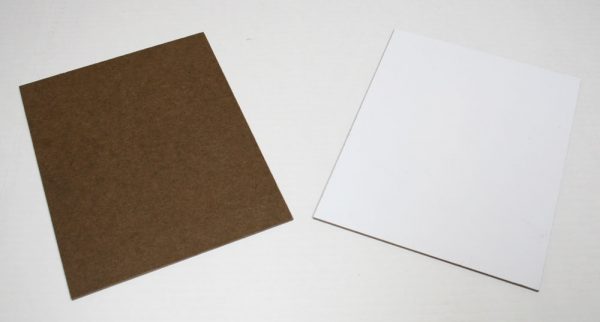
I used to buy canvas panels already made from companies like Ray Mar and Source Tek, but I decided that it would be more cost-effective to make my own. I was already buying large rolls of oil-primed linen for my studio paintings anyway. Plus, making the panels myself allows me to make whatever sizes I want. Both Ray Mar and Source Tek make great products (I still purchase other items from them), and it’s definitely more convenient to just buy the panels from them. But with a little extra work it’s pretty easy to make my own.
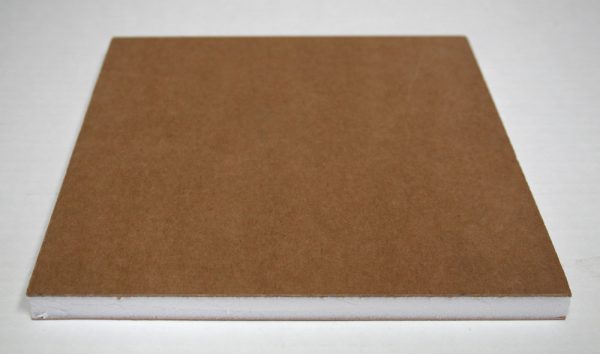
Any type of linen or even cotton canvas can be used to make panels, but I use Claessens #15 double-oil-primed linen (since I paint with oils and prefer the behavior of linen compared to acrylic-primed cotton). The #15 is a tight weave and considered to be a portrait-grade surface. (There are many different weaves of linen — some rougher and some smoother.) I generally buy the 82″ x 6-yard roll of the linen from whichever company is offering it for the lowest price. It has often been cheapest at Jerry’s Artarama, but I always shop around a bit online to find the best deal.
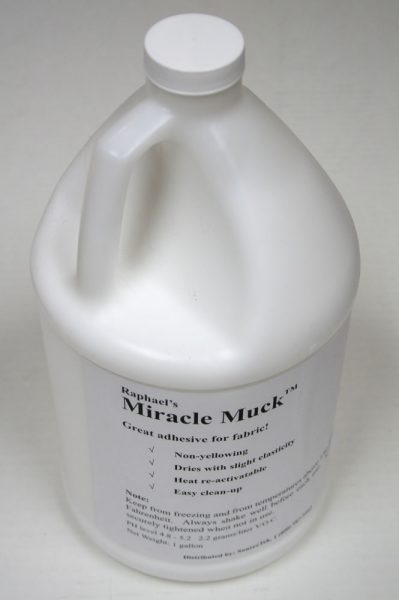
The next item that I use to make my panels is 1/8th-inch hardboard (sometimes called “masonite” or “marker board”) onto which I mount my linen. I currently buy it from Home Depot or Lowe’s and can usually find it in the paneling section (although both stores seem to change the products they carry from time to time). The hardboard is very resistant to warping and is smooth wood on one side and coated with a smooth white surface on the other side. (I like the smooth white surface because it makes a nice clean back for my finished paintings where I can write my title and other information.) I usually buy it in 4-foot by 8-foot sheets, which a friend of mine generously cuts on his table saw to whatever sizes I need. (Home Depot and Lowe’s can cut the panels, but they charge for each cut. Actually, maybe I should figure out how to keep my friend from reading this post….)
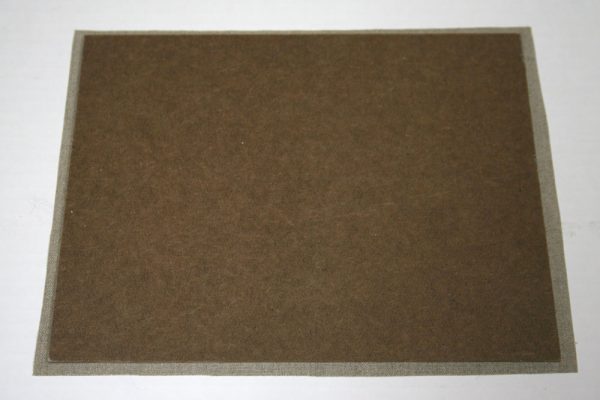
On a side note, I generally make panels for my larger studio paintings as well, but instead of using hardboard I use 3/16″ or 1/2″ Gatorfoam®. It’s easy to cut to any size I need, resistant to warping and lighter than hardboard which makes it cheaper to ship. I glue linen to it just like I do when making panels on hardboard. I buy it from a local moulding company.
The glue I use to adhere the linen to the hardboard is a product made by Raphael’s called “Miracle Muck.” It creates a strong flexible bond and has a neutral pH when dry. It’s also heat-reactivatable if it ever becomes necessary to remove the linen from the hardboard. Source Tek sells a similar product called ArchivaBond.
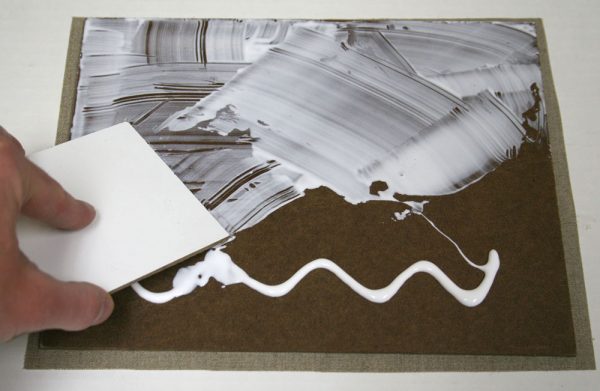
Once I have all the materials and I’m ready to make some panels, I have to gather a few other things. I use a pair of scissors to cut the linen, something to spread the glue with (I just use a small 3″x5″ piece of the hardboard), a rolling pin and something to use as weight on top of the glued panels while they dry (I use a stack of nice hefty art books).
The next step is to cut the linen so that I have a piece for each panel that I want to make. I cut each piece of linen so that it has about 1/4″ extra on each side of the piece of hardboard. For example, an 8″x10″ panel requires an 8-1/2″x10-1/2″ piece of linen (the linen will shrink a bit with the wetness of the glue).
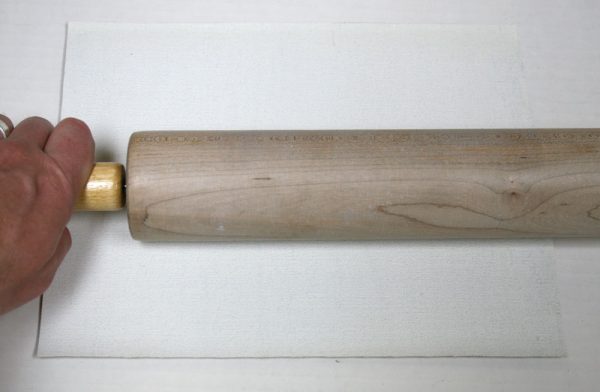
Next I apply the Miracle Muck® to the smooth wood side of the hardboard and spread it around to evenly coat the surface. Then I flip the panel over so that the linen side is up and use a rolling pin to roll out any air bubbles between the hardboard and the linen.
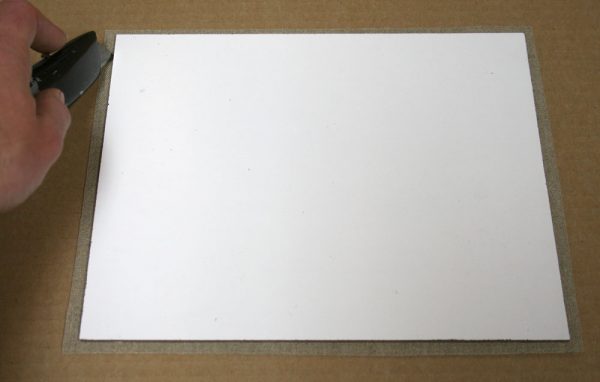
Then I flip the panel over again (so the linen side is down, which will keep any excess glue from dripping off the edges of the panel onto the table) and stack books on top of it to weigh it down as it dries. It usually takes a few hours to dry before it’s ready to trim. Trimming is quite easy and only takes a few cuts with a utility knife to remove the excess linen from the edges of the panel. Then it’s ready for a painting trip! It’s quite convenient to have a stack of panels made and ready to go whenever I have the opportunity to paint outdoors, so I like to keep at least eight or ten panels in various sizes ready at all times.
(An added bonus: A canvas panel can be flung much farther than a stretched canvas when you’re not satisfied with your plein air attempt!)
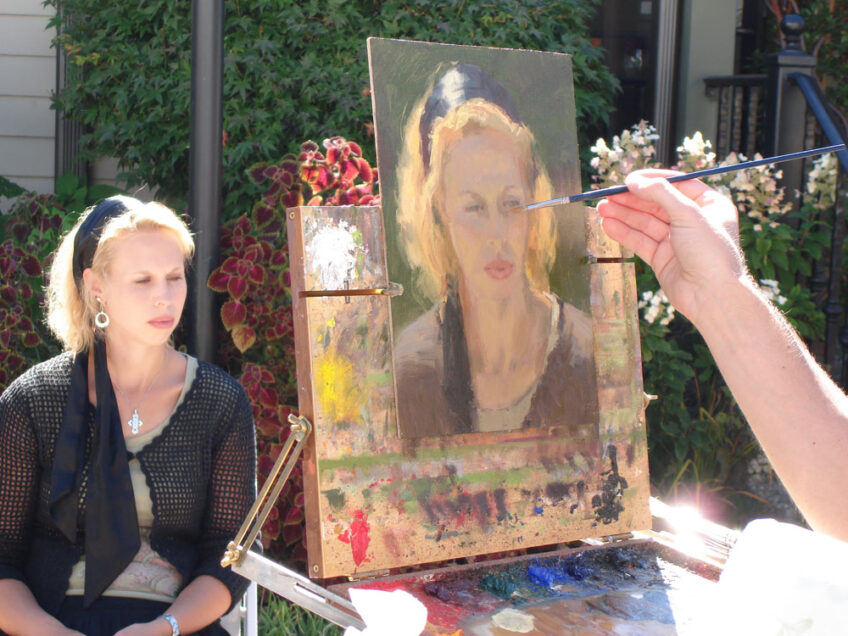
61 Responses
Julia Evans
Hey Dan, thanks for posting this!! Tim brought home some masonite that was used for spacers in some school project, then discarded. We trimmed them, got out the Miracle Muck (I love that stuff) and some Frederick canvas, and have a nice stash of panels to work with. AND we’re repurposing/recycling, so I feel good about that.
I’ve been using Miracle Muck to glue 300# watercolor paper pieces to gallery-wrap canvases, which is a cool way to avoid framing contemporary mixed media pieces. Leftover pieces of illustration board or matte board make good spreaders, too.
Dan Schultz
Thanks for the comment, Julie — I’m glad you found the post helpful! And thanks for the info about using Miracle Muck for watercolor paper too!
E. Melinda Morrison
Dan, love that you posted this. I have been doing this for several years and like you, still buy items from SourceTek and RayMar but it is easier to adjust sizes if I make them my own. A quick tip: since i live in Denver, it is a drier climate. Glue tends to crack over time in dry climates so i went to Denver Bookbinding here and bought their glue. It is used for acid free paper and it has polymers in it that helps hold together and will not crack over time. It is half the price of Miracle Muck. I take a jar and fill it up, so a gallon is about $30. So, artists can check and see if there is a book binding factory in their area. Most will sell their glue.
Dan Schultz
Thanks, Melinda — what a great idea to buy glue from a bookbinder!
Linen Snobbery (Linen vs. Cotton Canvas) Dan Schultz Fine Art
[…] down on panels. (I’ll save that reasoning for another post. By the way, if you would like to learn how to make your own linen panels, click the link see my earlier post about […]
Stretched Canvas vs. Canvas Panels Dan Schultz Fine Art
[…] you may know, I’ve been making my own linen panels for several years. (Click here to learn how.) But you might not be aware that I paint almost exclusively on panels. Here are eight reasons […]
Hans Eric Olson
Hey Dan,
I just bought a roll of Classens Oil primed linen and want to use your method for mounting the linen on masonite board. One question I have…I want to do a 30″x 40″, would you suggest using the gator board for this size? I’m going back and forth between larger stretcher bars or gluing the linen to a surface.
Any suggestions would be appreciated!
Thanks…H O
Dan Schultz
Hi Hans,
In my opinion, you’ll definitely want to avoid using Masonite at that size — the panel will end up being quite heavy. The Gatorfoam will be much lighter in weight, but still rigid. I’ve used both the 1/2″ and the 3/16″ Gatorfoam at that 30″ x 40″ size and haven’t had any problems.
Good luck!
-Dan
Sandra Bos
I like this idea and will try it, but, I used to just gesso the board, and it worked just as well.
Adele Earnshaw
Dan, thanks so much for this information – exactly what I needed!
Mike
Hi! Dan, thanks for a great article, just a question, do you paint on linen just taped to a board and then glue onto Gator Board when finished, being careful of course not to get glue on the painting, or do you always do your boards first. I have paintings on linen but feel stretching them would cause cracking later, love your opinion thanks
Dan Schultz
Hi Mike — I glue virtually all of my panels before I paint, but I have mounted a few canvases after painting on them. I think you mostly just have to be careful to avoid squashing any thickly painted areas when using a rolling pin to secure the canvas to the panel. I’ve found that the paint remains fairly pliable though. I don’t think you’d have to worry about any cracking. Good luck!
Mike
Thanks Dan appreciate your input.
Ana lee
Do I need to gesso or prime both sides of wood panel before adhering the linen?
Dan Schultz
Hi Ana — you just need glue on one side of the panel before adhering the linen. No need to prime or gesso.
Angela Holland
I have been doing mixed media collage on wood panels and want to start working larger. Would a linen surface hold up to a lot of glued paper as well as acrylic paint when subsequently attached to a Gatorfoam panel? I’m thinking 4×6′ size, which gets too heavy in wood. Looking for a workable alternative. Any advice appreciated!
Dan Schultz
Good question, Angela. I’m thinking it would work to do your collage idea on a linen gatorfoam panel. You could probably even use a cheaper cotton surface mounted to gatorfoam as long as the canvas is well-sealed with gesso. Then you don’t have to pay for more expensive linen.
Juliana
Hi Dan. Great post thanks. What is the largest size board I need to worry about before seeing warping? Also do you know or notice if the marker board warps less than hardboard/Masonite because of the white backing? Last does it matter if it’s tempered or non-tempered hardboard that will better adhere the glue to linen better? Some other blog posts have suggested using rubbing alcohol on the surface of tempered first before glue as well as painting the other side to avoid moisture/warping. But maybe warping has to do with size of board? Thoughts. Thanks so much.
Dan Schultz
Hi Juliana. I’ve made linen panels as large as 18″ x 44″ using hardboard. At that size the panel didn’t really warp as much as just flex when moved because of the weight of the panel which became significant. It was quite heavy. Once it was secured in its frame there wasn’t any sign of warping, though it was definitely heavy to hang. (Which is why I decided to start making my larger panels on much lighter Gatorfoam instead.) I’ve never really experienced warping with hardboard the way I’ve seen it with birch plywood. The marker board seems to be even less prone to warping because of the stiff backing.
From what I’ve read, untempered hardboard is the way to go since it hasn’t been treated. Tempered boards are treated with oils that may eventually harm the wood and possibly a canvas attached to it. I think this choice is most critical when gessoing a board and painting directly on it. However, since we’re gluing linen to a panel, an acid-free glue provides a barrier between the board and the canvas which helps protect the canvas from any acids or harmful elements in the wood. For the same reason, it’s unnecessary to gesso the back of the panel since we’re not painting directly on the wood. This is why I like the heat-reactivatable glue, Miracle Muck. If a problem ever arises with the wood panel, the glue can be heated and the linen removed from the panel and attached to another support.
I hope this helps!
Juliana
This helps answer any doubts. You are very thorough in your answer and I really appreciate the time you’ve taken to post this blog of step by step and answer everyones questions for 4 yrs. Especially mine ;).Thank you. I know this will help others with these little nagging doubts we have as well.
Dan Schultz
Glad to help, Juliana.
Diane
Have you ever tried Beva 351 film as an adhesive? It is heat activated (150F), and you can iron it on. I’ve used my oven (was worried about ruining the painting with an iron- it was already done before I mounted it)for smaller panels but have not tried larger ones with the iron. Wondered about your thoughts glue vs. film, if you have.
Dan Schultz
Hi Diane,
Thanks for your question. Sorry to say, I don’t have any experience with film adhesive. I’ve never had any problems with Miracle Muck as mentioned above, so I keep using and recommending it. It’s a good product.
Noel
Dan, thank you for this thorough explanation. I’ll be trying it as soon as I get the glue! One question, though, do you prime your surface after the board dries? Or will it shrink or warp? I don’t use pre-gesso’d canvas, and had planned to gesso the canvas to the board before reading this. No idea if that would have worked. Thank you for your years of answered questions!
Dan Schultz
Hi Noel,
I always buy pre-primed linen so I don’t do any priming once I’ve mounted the linen to the panels. Linen or cotton canvas will shrink a little from the wetness of the glue so I always allow some excess canvas around the panel, then trim it off once the glue is dry. I haven’t had many warping problems with 1/8″ masonite or MDF, but I stay away from birch plywood since I’ve seen more warping with it. However, if your panels get larger than 16″ x 20″ you may see more warping. As I mentioned above, Gatorfoam is a great alternative for larger panels since it doesn’t warp much and is very lightweight.
Portrait Painting Workshop
[…] Claessen’s #66 linen canvas panel to each student. (They also make the Miracle Muck glue that I’ve recommended before for making canvas panels.) • Rosemary & Co. supplied a free #2 Series 279 brush to each […]
Charles Smith
Dan,
I too have made my plein air painting panels for years. I typically paint a lot of 9 x 12’s and 11 x 14’s.
My process is much like yours but I found what I think is a better way to get my Gatorfoam panels.
A company called Harbor Sales in Maryland has a website where you can designate the number and size of panels you want cut from a 4 x 8′ or 5×10′ Gatorfoam sheet. (And they offer a complete range of gatorfoam products). The panels are uniformly computer cut and there is an on-screen algorithm to allow you to get the maximum number of cuts with minimum waste.
You can optimize how many of each size you want and how they best can be cut from a single sheet with least waste.
They do charge for cutting and shipping but I find it worth it because I don’t have to pay for shipping for oversized gator foam boards, and I can store my package of uniform sizes conveniently until they are needed. And I don’t need a large table on which to set up my own cutting. And finally there’s no risk to my fingers from my box cutter.
This may not be a solution that works for you but I thought I would offer it if you haven’t already checked into it. I’ve ordered from them a few times and have always been pleased with their service and their product.
Thanks for the discussion and for your great paintings.
Charles Smith
PS I’m in Louisiana and have no relationship at all with Harbor Sales, other than being an occasional customer.
Dan Schultz
Thank you for your great recommendation, Charles. I think a lot of people will be glad to know that Harbor Sales can cut the Gatorfoam to the sizes they need.
Faith
Wow. THANK YOU. So glad I stumbled upon this! 🙂
Denise
Dan, when you cut the linen to fit the hardboard, do you seal the edges so there is no fraying?
Dan Schultz
I don’t seal the edges, Denise — and I’ve never had any problems with fraying. 🙂
Patricia Mooney
What brand of gatorfoam do you use? I understand there is a difference in archival quality? Is gatorfoam and gatorboard the same? Is there a reason you do not roll the Miracle Muck on to the linen and prefer to roll on the board? Would rolling on both be too much?I have a painting on Classens oil primed linen I want to glue down that is already finished except for some fine details; it is 14×20. It does not have thick paint . What major mistake should I be aware of in applying the Miricle Muck? I do not want to mess this up. Thanks so much for your post and continued replies. They are extremely helpful.
Dan Schultz
Hi Patricia,
First of all, to my knowledge, Gatorfoam and Gatorboard refer to the same thing. Gatorfoam is the proper name for it. But I’ve also used a product called Mighty Core, which is similar but slightly less rigid. I don’t think that either is acid-free, but I don’t worry much about it because the archival Miracle Muck glue creates a barrier between the board and the canvas.
I apply the glue to the board rather than the linen because I cut the linen slightly larger than the board. If I applied the glue to the linen, the excess around the edges would end up sticking to my workable when I would flip it over onto the board. Hopefully that makes sense. The glue only needs to be applied to one surface.
Just follow my process above for your project and it should work fine. Use a rolling pin to roll across the canvas several times after gluing, then stack books or something similar on it to weigh it down as it dries. Good luck!
Mark
I make my own panels also but I will cover the entire wood panel with canvas first, and let it dry to get good adhesion. Then I cut the canvas vocered panels to the size I want on my table saw. Quicker, easier, instead of fussing with a number of individual panels.
Linen Snobbery (Linen vs. Cotton Canvas)
[…] down on panels. (I’ll save that reasoning for another post. By the way, if you would like to learn how to make your own linen panels, click the link to see my earlier post about […]
anon
Gatorfoam and Gatorboard are not the same. See, for example– http://www.displays2go.com/Article/Gatorboard-Foam-Core-63
Katherine Martinez
If we are okay with never removing the painting from the panel would using bookbinding PVA glue be okay to use as an alternative to the Miracle Muck?
Dan Schultz
Katherine: as far as I know, yes. I know some artists who use PVA glue for their panels.
amy
OMG. I’m not the only one who flings paintings out the front door and into a culvert. And then goes back out and flings it at the garage. Than goes back out and runs over it.
Lol.
Thank you for the step-by-step. This sounds like something I can do.
Donna
You mention Gatorfoam in your replies. I use Gatorboard and I believe there is a big difference between the two. Gatorfoam is much more flexible than Gatorboard, which is very rigid and strong. Please clarify.
Donna
Dan Schultz
Hi Donna, as far as I know Gatorfoam is the proper name of the actual product. Some people refer to it as Gatorboard but it’s actually Gatorfoam. If you used something that was flexible then it wasn’t Gatorfoam.
Giulia
I inherited boxes and boxes of fine linens, from sheets down to handkerchiefs. Some are monogrammed, many are embroidered. I’m just crushed to get rid of them and I don’t have servants to wash and iron them! So, i thought I could make a line of fine linens and cotton panels for artists. What do you think?
Susan Van Iderstine
Hi, I just saw this. I love vintage linens, and I use them every day. Mostly I have items that were given to me by people (like you) who inherited them and don’t plan to use them. I would love to know what you have that would be towel / tablecloth or sheet size.
Cheers, Susan
David Bugeja
I stumbled upon your post whilst searching for linen canvases. Linen canvas is amongst the most durable canvases that is also less sensitive to relative humidity fluctuations (which, in the long run, it will prevent deformations as well as paint cracks and detachment). But… adhering such a luxioruous canvas to an acid-rich wooden support makes my eyes water. First of all… please do not make use of such adhesives that tend to degrade. Avoid adhering linen to wood espescially manufactured wood – such as chipboard or hardboard – as it contains a ton of acedic adhesives. I apologise for spilling the bad news, but I am sure that this information is important for all of you who love permanence. Just stick to the traditional way of stretching linen canvas on a wooden frame. And if you want something sturdy, you may stretch a canvas on a wooden support, stapling it along its taking margins. But the latter should be temporary – you may later remove the canvas and stretch it on a stretcher frame. Cheers, stay safe, and have fun painting!
Dan Schultz
Thanks for your insights, David. My understanding is that an acid-free glue layer (like the Miracle Muck that I use) provides an effective boundary between the wood panel and the canvas, so that the canvas is protected from any acidity in the wood. I’ve spoken about this with the makers of Miracle Muck and also with a manufacturer of canvas panels for artists. So as far as I know, it’s an effective and safe system for making panels on the various supports.
Judy Steininger
Hi, Dan.
I mounted a piece of linen canvas to an ampersand hardbord panel using PVA glue. Nice and flat. Worked on the painting for months. Nice and flat. Now that the painting is done (I haven’t varnished it yet), air bubbles have developed between the canvas and the board. They’re small in size but a lot of them. Any suggestions for how to get rid of the air bubbles? Or is there a way to remove the canvas from the board without too much damage so I could remount it?
Dan Schultz
Hi Judy,
Sorry to hear about your bubble problem. I’ve had that happen a few times and have tried to identify the cause. In my case, I had used what turned out to be a substandard board to mount the linen on. I normally use hardboard or Gatorfoam. But I had bought a product called Mighty Core that is similar to Gatorfoam, but slightly less rigid. (My supplier was out of Gatorfoam at the time.) So I think that the board being slightly flexible and having a different surface quality didn’t allow the glue to adhere properly. The other possible variable is that perhaps I didn’t press firmly enough when using my rolling pin to flatten the linen onto the board after applying the glue.
So…. I’ve tried a couple of different ways to fix the problem. First, I used a hair dryer to heat up one of the canvases and slowly peeled it off of the board. (The Miracle Muck glue I use is heat-activated. I’m not sure if your PVA glue would allow removal or not.) Then I re-glued the canvas onto a fresh Gatorfoam panel. Because the linen was re-wet when gluing, it shrunk slightly, causing some buckling of the paint in a few areas. So that required repainting to finish the job. Needless to say, a time-intensive process!
The second way I’ve tried is to use a small syringe with glue in it to inject glue into the bubbled areas. Then I pressed them down to flatted them again. Then I painted over the small holes I made to inject the glue. It’s a much easier process, but if there are a lot of bubbles it could take awhile.
The lesson I’ve learned is to stay away from the Mighty Core board. I haven’t had any problems with Gatorfoam panels or hardboard panels. So I’m not sure if your glue might be the issue? Or not pressing hard enough when gluing?
I hope that info helps and that you’ll be able to salvage the painting!
Zach Ross
Hi Dan, thanks so much for the article! Where would you say the best place to buy gator foam board is?
Dan Schultz
Hi Zach. You should be able to buy Gatorfoam from a moulding company. I get mine from Valley Moulding in North Hollywood, CA — they deliver the 48”x96” sheets to me in one of their vans for a small delivery charge.
Jamie
Hi Dan,
Are you still using Miracle Muck, and if so, where are you buying it? Raphael’s (supplier of Miracle Muck) in California went out of business in 2018, and had a liquidation sale. I see they have now set up shop in Oklahoma. I wonder if they are selling old stock left over or have been manufacturing new stock since then. Perhaps you know the answer to this?
Thanks,
Jamie
Dan Schultz
Hi Jamie,
I’m still using Miracle Muck, but haven’t had to replenish my stock since Raphael’s moved to Oklahoma. I don’t know whether they are still manufacturing it, but I would assume that they are. An alternative would be to check out SourceTek (CanvasPanels.com) — they’re selling an archival adhesive called Archiva Bond. I may try it when I need to get some more glue.
Jamie
Thanks Dan!
Johnny Huerta
Hi Dan! I’ve been researching and reading this thread on making canvas panels. Currently, I use 1/8 inch thick MDF which I seal with several layers of GAC 100 before either mounting my claessens 15 DP linen, or layering 5-7 coats of gesso to paint directly on the panel. This works great for small works. One of my latest paintings was a 48”x60” panel which I sealed, gessoed and painted directly on. I used 1/4 inch thick MDF since it was a larger piece. Of course, the panel has some flexibility but is holding its shape really well. I was wondering if this is anything to be worried about over time? I just recently cut some 1/4 inch 30”x40” panels for mounting. My initial idea was to get a slightly thicker panel for a larger work, but then I thought that perhaps maybe the heavier weight is more likely to bend? Perhaps 3/16 inch? In this thread I realize you mention gatorfoam for your larger studio works, but I simply prefer the solid panel rather than a foam core look. I wanted to know your thoughts on using panels for larger works. I also just realized there may be a difference between MDF and hardboard?
Thanks!
Johnny H
Dan Schultz
Hi Johnny,
I haven’t painted on wood panels larger than 16″x20″ for many years because of the weight. So I’m not sure if they could warp over time at those larger sizes. I wouldn’t think so, unless they were in a very moist environment. I haven’t had any warping problems with the gatorfoam and I’ve heard of some artists who have painted on full sheets of it (after mounting canvas on it) — 48″x96″. It’s a great product for large sizes and keeps them as lightweight as possible for shipping and hanging.
John Huerta
Hi Dan. How exactly do you reactivate miracle muck using heat? I mounted a canvas to a board that came out horrible. It’s a 30x 40 board so I do not want it to go to waste. I was wondering if I can still somehow salvage the canvas.
Thank you
Johnny
John Huerta
Hi Dan. How exactly do you reactivate and reverse miracle muck using heat? I mounted a canvas to a board that came out horrible. So many air bubbles and bumps. I think I used too much glue and took too long to mount the board. The stuff seems to dry faster than other adhesives I’ve used. It’s a 30x 40 board so I do not want it to go to waste. I was wondering if I can still somehow salvage the canvas and remount it. I’m finding plenty of claims of “reversibility” when it comes to mounting adhesives, but nowhere is there any instruction on how to do it for any product.
Thank you
Johnny
Dan Schultz
Hi Johnny,
Yeah, the larger panels are tougher to make for sure. I have removed a canvas from a glued panel once (incidentally it was also a 30×40) and I was somewhat successful. I used a hair dryer to soften the Miracle Muck, starting in one corner and slowly pulling the canvas away from the panel, being careful not to crease or otherwise damage the canvas while gripping it. You have to pull pretty hard. The key is to do it slowly. With mine, some of the surface of the panel peeled off with the canvas, so I then carefully scraped most of that away with a flat palette knife (being careful not to slice the canvas). I then re-glued the canvas to a new panel. Be aware that the canvas will shrink slightly due to the wetness of the glue. So your 30×40 might become a 29×39 or so. (This might depend on the type of canvas you have. Mine was Claessens #15 double primed linen.)
Another (easier) alternative: get a small syringe you can use with glue (try a craft store), poke a tiny hole into the air bubbles on your canvas and insert some glue into the hole and then place a book on top until it dries. Then you can use some primer or paint to cover the hole. I’ve done this on a couple of panels that had some bubbles. So maybe this will work for you if your canvas doesn’t have too many bubbles. Good luck!
Kim Swanson
This is great, thank you, I tried my hand at making these last night and wish I had found your article first. I loved the last line! :).
I would only add to use a rotary cutter to cut the linen canvas which is a total game changer! I have the Olfa 45mm rotary cutter and use a metal straight edge and the Logan FoamWerks cutting system and a self healing cutting mat.
Dan Schultz
Great tip, Kim — thanks!
Judy Nelson
Hey Dan,
I love Jerry’s house brand oil primed linen (centurion), but they stretch it using flimsy bars, so I’ve been mounting it on Masonite. I’ve used Mod Podge as an adhesive, which was okay but tricky to get wrinkles out ( I was mounting finished paintings). I’ve had some trouble with Lowe’s Masonite warping slightly, wondering if your product that’s white on one side might be more stable? I also ventured into Lowe’s birch veneers panels, looking for lighter weight, but they came pre-warped 😁. Love the suggestion about looking for a book binder for glue!
What a helpful article, and great comments!
Dan Schultz
Glad you found the post helpful, Judy. I haven’t had issues with any warping with the white-on-one-side hardboard, so maybe you’ll want to try that. Also, give Gatorfoam panels a try for light weight and very limited warping.